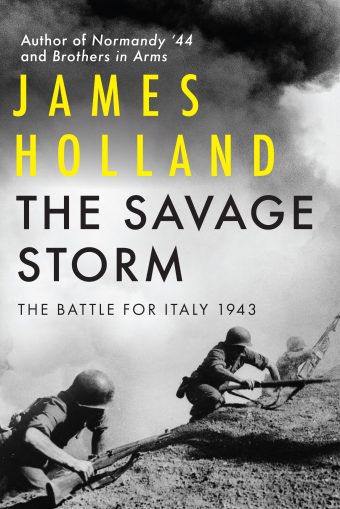The Savage Storm: The Battle for Italy 1943
- By James Holland
- Atlantic Monthly Press
- 480 pp.
- Reviewed by Steven Groff
- January 17, 2024
This illuminating account of a storied invasion fills in the gaps between strategy and reality.

James Holland has written quite a number of books about different aspects of the Second World War. In his latest, The Savage Storm, he offers a fascinating account of the Allies’ victory in Sicily in August 1943 and their subsequent attempt — and failure — to capture Rome that year.
Throughout, the author effectively outlines the strategy and events surrounding the Italian Campaign while describing conditions on the ground through the eyes of the men and women who were there. He uses personal diaries, letters, and unit reports from both the Allies and the Axis, as well as from locals caught in the middle, to take readers along on the first half of what would be a 10-month ordeal. These personal stories paint a gripping and often tragic picture of what soldiers and civilians alike had to endure. (Fair warning: Some of the descriptions are quite graphic.)
Following relatively easy success in the taking of Sicily, the Allies struggled with the next step against Germany. They were not yet ready for the large-scale, cross-Channel invasion that would happen on D-Day in June 1944, so a short jump across the Strait of Messina to mainland Italy seemed a good choice. But where along the boot to land?
Holland defines the goals the Allies hoped to achieve: Knock the post-Mussolini Italy out of the war; tie up German troops so they couldn’t fight against the Soviet Union or defend against the eventual invasion in France; secure crucial airfields in southern Italy to allow Allied airpower to attack deep inside Germany; and finally, capture Rome by Christmas 1943.
With the exception of capturing Rome, all the objectives were met. However, Holland shows the enormous cost of that “success” and demonstrates how the invasion’s aims were perhaps poorly thought through. One point he repeatedly makes is that the military leaders who decided to invade southern Italy (and who were not the commanders in the field) may have grasped the challenges of the mountainous terrain on paper but not in reality:
“Italy, it was all too clear, was a defender’s dream. And an attacker’s nightmare.”
Aside from the unforgiving landscape, another key hurdle, explains Holland, was the shortage of supply ships and landing craft, which severely limited options for the armies on the ground. Resources were necessarily being redirected to support the impending Normandy landing, thus limiting what the Allies could do. Further, the mountains and horrible weather neutralized their enormous advantage in airpower and armor. (The Allies’ underestimation of how hard Germany would push back didn’t help, either.) Ultimately, the result was casualty numbers among the infantry proportionally higher than on the bloody Western Front in World War I, exposing the suffering and morale problems on both sides.
Holland’s discussion of the Italian perspective is especially illuminating. Soon after the invasion, Italy surrendered and joined the Allies. “And so it was done,” writes Holland. “The Italians were out of the war, and the endless pretence, lying, duplicity and double dealing was finally at an end.” Many in Italy naïvely assumed this would stop their suffering: Mussolini was gone, the Germans would leave, and the Allies would simply move in. Instead, the Germans sent more divisions to defend Italy’s southern flank, and the only way to evict them was via massive firepower from the ground and air.
The resulting fighting was brutal and the destruction of towns, villages, and citizenry immense. For the Italians, it was truly a paradox: They were liberated from German oppression but at the cost of arguably more suffering. In the end, it doesn’t matter whether your home is flattened by friend or foe — it’s still gone. James Holland captures that reality beautifully in The Savage Storm. I recommend it to anyone interested in learning more about the human face of WWII.
Steven Groff is a retired intelligence officer, docent at the National Cryptologic Museum, enthusiastic student of American and British history, and self-described history geek.

